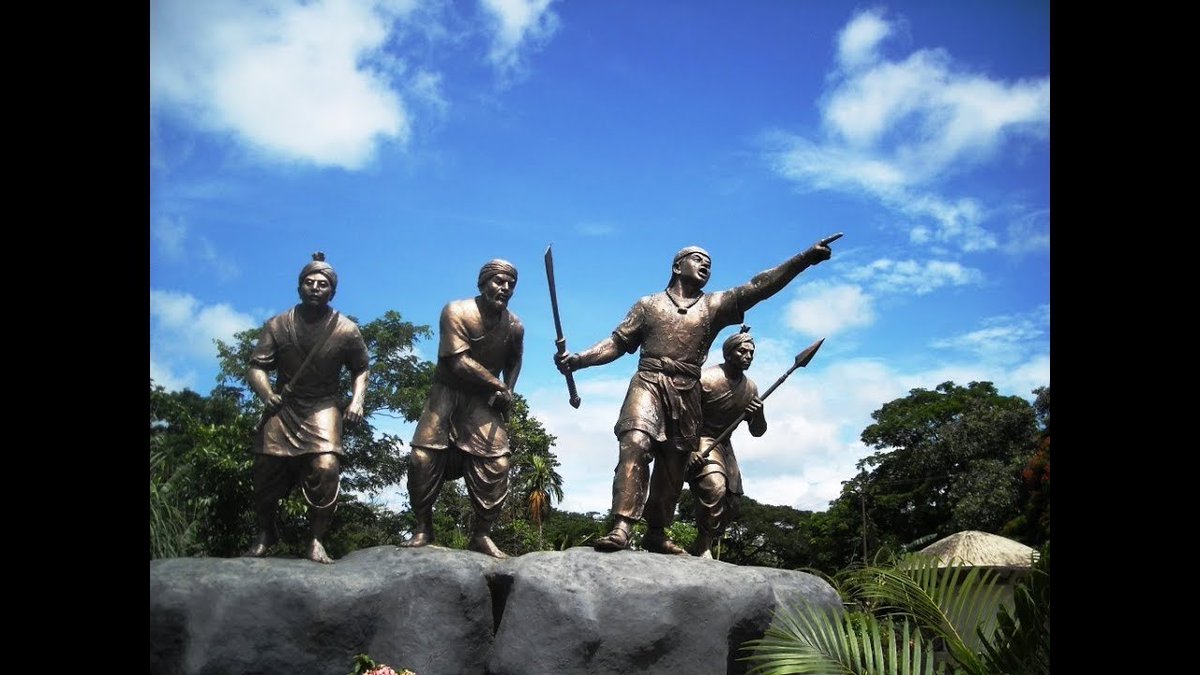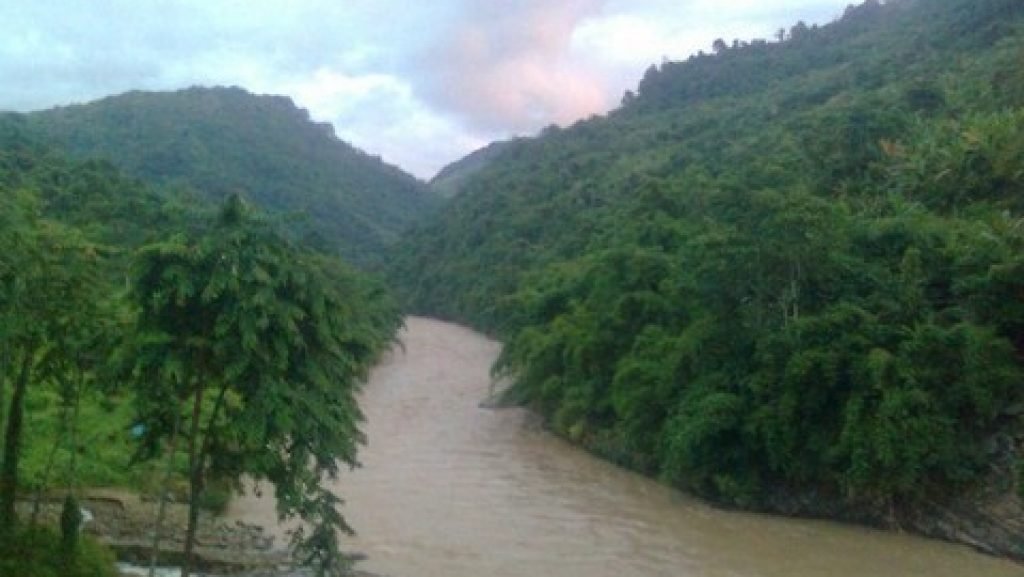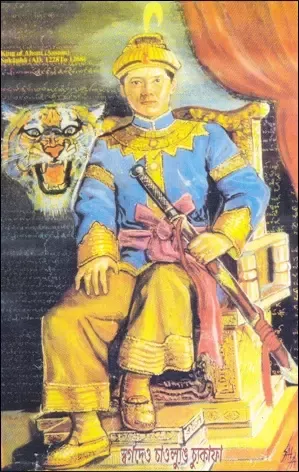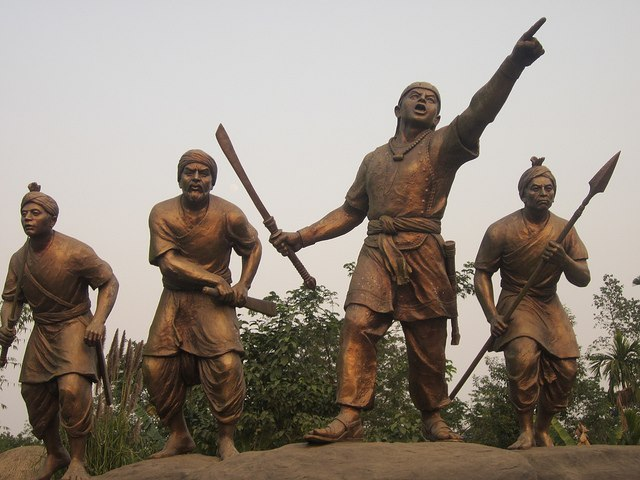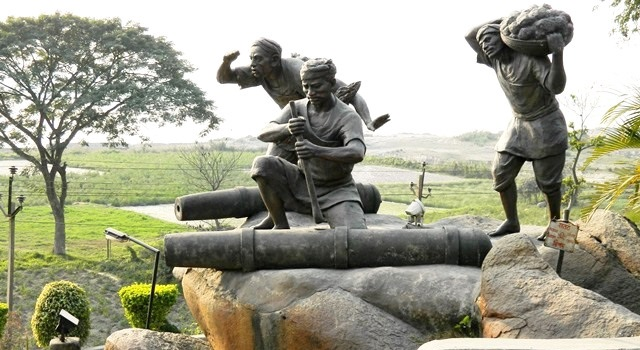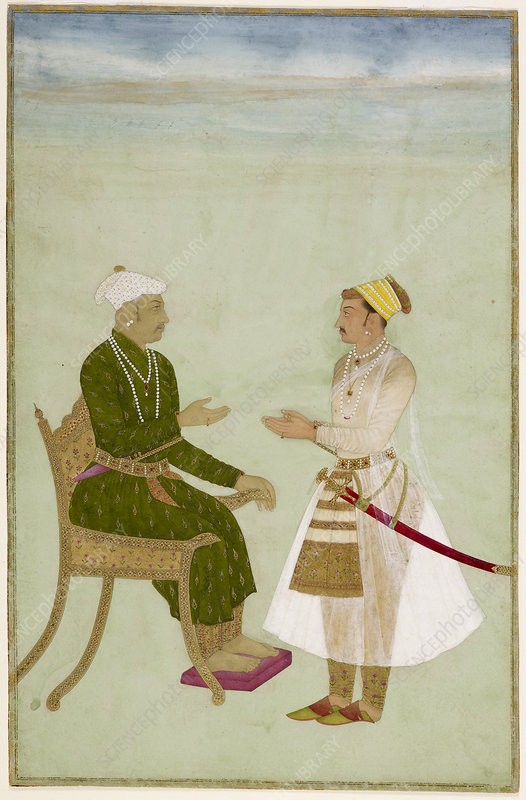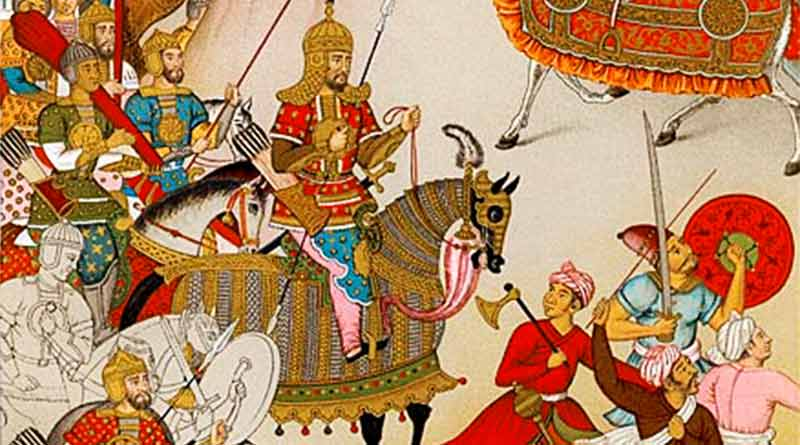Thread on Mighty "AHOMS" and Battle of Saraighat where Mughals lost to much smaller army of ahoms led by Lachit Borphukan.
The Ahom kingdom was established in 1228 when Sukaphaa entered the Brahmaputra valley. Sukaphaa did not battle any established kingdom and seem to have occupied a depopulated region on the south bank with the Burhidihing river in the north, the Dikhau river in the south--
-- and the Patkai mountains in the east. He befriended the local groups, the Barahi and the Marans, finally settled his capital at Charaideo and established the offices of the Dangarias—the Burhagohain and the Borgohain.
The Ahoms brought with them the technology of wet rice cultivation that they shared with other groups. The peoples that took to the Ahom way of life and polity were incorporated into their fold in a process of Ahomization.
Groups like some Nagas and the Maran peoples became Ahoms, thus enhancing the Ahom numbers significantly.
Rang Ghar, a pavilion built by Pramatta Singha in Ahom capital Rongpur, now Sibsagar; the Rang Ghar is one of the earliest pavilions of outdoor stadia in South Asia.
Rang Ghar, a pavilion built by Pramatta Singha in Ahom capital Rongpur, now Sibsagar; the Rang Ghar is one of the earliest pavilions of outdoor stadia in South Asia.
Hindu influences, which were first felt under Bamuni Konwar at the end of the 14th century, became significant. The Assamese language entered the Ahom court and co-existed with the Tai language.
The kingdom came under attack from Turkic and Afghan rulers of Bengal, but it withstood them. On one occasion, the Ahoms under Tankham Borgohain pursued the invaders and reached the Karatoya river.
The kingdom came under repeated Mughal attacks in the 17th century, and on one occasion in 1662, the Mughals under Mir Jumla occupied the capital, Garhgaon. The Mughals were unable to keep it, and in at the end of the Battle of Saraighat --
-- The Ahoms not only fended off a major Mughal invasion, but extended their boundaries west, up to the Manas river.
Battle of SARAIGHAT :
The Battle of Saraighat was the last battle in the last major attempt by the Mughals to extend their empire into Assam. Though the Mughals managed to regain Guwahati briefly after a later Borphukan deserted it.
The Battle of Saraighat was the last battle in the last major attempt by the Mughals to extend their empire into Assam. Though the Mughals managed to regain Guwahati briefly after a later Borphukan deserted it.
The Ahoms wrested control of Guwahati back in the Battle of Itakhuli in 1682 and maintained it till the end of their rule.
Mughal imperial demands were tactfully and diplomatically rebuffed, but when the new faujdar of Guwahati, Firuz Khan, forced the matter in March 1667,
In August 1667 the Ahom army, under Lachit Borphukan accompanied by Atan Burhagohain, sailed downstream to retake Guwahati.
In August 1667 the Ahom army, under Lachit Borphukan accompanied by Atan Burhagohain, sailed downstream to retake Guwahati.
Lachit made Kaliabor, the old seat of the Borphukan, his base camp and advanced toward Guwahati along both banks of the Brahmaputra. On the north bank the Deka Phukan retook Bahbari in early September 1667.
On the south bank, the Nausalia Phukan and others, moving on land and water, captured Kajali, Sonapur, Panikhaiti, and Titamara forts between the Kapili river and Guwahati.
Guwahati which was defended by five choukies on each bank of the Brahmaputra (north—Kanai-borosi-bowa, Hillar, Hindurighopa, Patduar and Korai; south—Latasil, Joiduar, Dharamduar, Duarguria and Pandu). With some loss, the Ahoms captured Shah Buruz and Rangamahal forts.
An extended battle was fought for the Itakhuli fort. The Ahoms besieged Joiduar, occupied Pandu.
The grand attack was launched on the night of 4 November 1667,when the Ahoms scaled the walls by ladders and after two months of siege, Itakhuli fell in mid-November 1667.
The grand attack was launched on the night of 4 November 1667,when the Ahoms scaled the walls by ladders and after two months of siege, Itakhuli fell in mid-November 1667.
Most of the defenders were massacred, many surrendered but a few managed to escape. War provisions, treasures and war material fell into Ahom hands.
The Mughals received some reinforcement at this point and retaliated against the Ahoms.
The Mughals received some reinforcement at this point and retaliated against the Ahoms.
Mughal emperor Aurangzeb was informed of the losses and he commissioned Raja Ram Singh of Amber, son of the famous Mirza Raja Jai Singh, to take back Guwahati. Ram Singh left Delhi on December 1667 and finally reached Rangamati in February 1669. He was accompanied by Rashid Khan
Aurangzeb augmented Ram Singh& #39;s forces of 4,000 troopers, 1,500 ahadis (soldiers recruited by the Emperor) and 500 barqandezes by an additional 30,000 infantrymen, 21 Rajput chiefs with their contingents, 18,000 cavalry, 2,000 archers and shieldmen and 40 ships.
Lachit Borphukan and the other commanders decided to choose the terrain of the battlefield with care. The choice fell on Guwahati, which was hilly, on the way to the heart of the Ahom kingdom and without open fields where the Mughal forces would not have sufficient mobility.
The Brahmaputra at Saraighat, was ideal for a naval defense.
Lachit prepared a complex system of mud embankments in Guwahati
When the Mughals found Guwahati impregnable by land, they would be forced to use their navy, which was their weakest asset.
Lachit prepared a complex system of mud embankments in Guwahati
When the Mughals found Guwahati impregnable by land, they would be forced to use their navy, which was their weakest asset.
When the Mughal march reached the Manas river and defeated some Ahom force, Lachit decided on a strategic retreat to Guwahati.
Three Rajkhowas were asked to meet the Mughal forces and retreat to Guwahati, keeping the Mughal force in sight but beyond the reach of their weapons.
Three Rajkhowas were asked to meet the Mughal forces and retreat to Guwahati, keeping the Mughal force in sight but beyond the reach of their weapons.
The Mughal forces were arraigned in four divisions
The north bank, commanded by Ram Singh himself.
The south bank, under Ali Akbar Khan, Raja Indramani, Raja Jaynarayan.
The Sindurighopa entrance, under Jahir Beg.
The river guarded by Latif Khan, Iswarpati,
The north bank, commanded by Ram Singh himself.
The south bank, under Ali Akbar Khan, Raja Indramani, Raja Jaynarayan.
The Sindurighopa entrance, under Jahir Beg.
The river guarded by Latif Khan, Iswarpati,
The Ahom defense was.
The north bank, under the command of Atan Burhagohain.
The south bank, under the command of Lachit Borphukan.
The north bank, under the command of Atan Burhagohain.
The south bank, under the command of Lachit Borphukan.
Exasperated with the delaying tactics of the Borphukan, Ram Singh asked for a duel with the Ahom king.
Lachit updated Chakradhwaj Singha about this proposal, who rejected the offer on the ground that it was beneath his dignity to duel a mere servant.
Lachit updated Chakradhwaj Singha about this proposal, who rejected the offer on the ground that it was beneath his dignity to duel a mere servant.
In a battle that was set up as a challenge, a force of 10,000 Mughals under Mir Nawab was to confront a force of 20,000 Ahom cavalry.
but instead of 20,000, they sent in 40,000 and using an anti-koch tactic that had worked against Chilarai, they dressed their vanguard archers-
but instead of 20,000, they sent in 40,000 and using an anti-koch tactic that had worked against Chilarai, they dressed their vanguard archers-
-- and musketeers as Brahmans to make the Rajput warriors desist from killing them. The battle took place in the fields adjoining the Alaboi hills about August 1669.
The Ahom soldiers were demoralised after their losses at Allaboi. Their commander-in-chief, Lachit Borphukan and their admiral were both seriously ill, and the Nara Raja, the son of the Miri Sandikoi, was in command.
An encounter both on land and water ensued near Ashwakranta. The Ahom land forces, under Laluk Borgohain Phukan, worsted the Mughals, but the Mughal boats compelled the Ahom boats to retreat to Barhila, north of Saraighat.
The battle reached a crucial phase, when the Mughals were beginning to get close to Andharubali. The Borphukan, as well as the Nara Raja sent messages to inspire the soldiers. It looked as if there was a break in command and some boats began falling back to Kajali and Samdhara.
At this crucial moment in the battle, when the Mughals were about to land at Andharubali, the Borphukan sent orders via katakis to all the land and naval forces to attack. He also ordered seven war-boats for himself and had Nadai of Kharangi carry him to a boat.
The entry of the Borphukan transformed the Ahom soldiers. His small flotilla soon swelled with Ahom warships from all sides that smashed into the Mughal warships at Amrajuli.
The triangle in the river, between Itakhuli, Kamakhya and Aswakranta was filled with men and boat.
The triangle in the river, between Itakhuli, Kamakhya and Aswakranta was filled with men and boat.
The Ahoms spanned the river over an improvised bridge of boats and resorted to a combined front and rear attack. The Mughal admiral was killed by a gunshot from the back, throwing the Mughals out of gear. They suffered the loss of three top-ranking amirs, and another 4000 dead.
The Mughals were pursued to the Manas river, the Ahom kingdom& #39;s western boundary.
Anticipating a counterattack, he set messengers at regular intervals, while Atan Burhagohain and other commanders stood ready for one.
Thus mughals were destroyed by ahoms in battle of saraighat
Anticipating a counterattack, he set messengers at regular intervals, while Atan Burhagohain and other commanders stood ready for one.
Thus mughals were destroyed by ahoms in battle of saraighat

 Read on Twitter
Read on Twitter